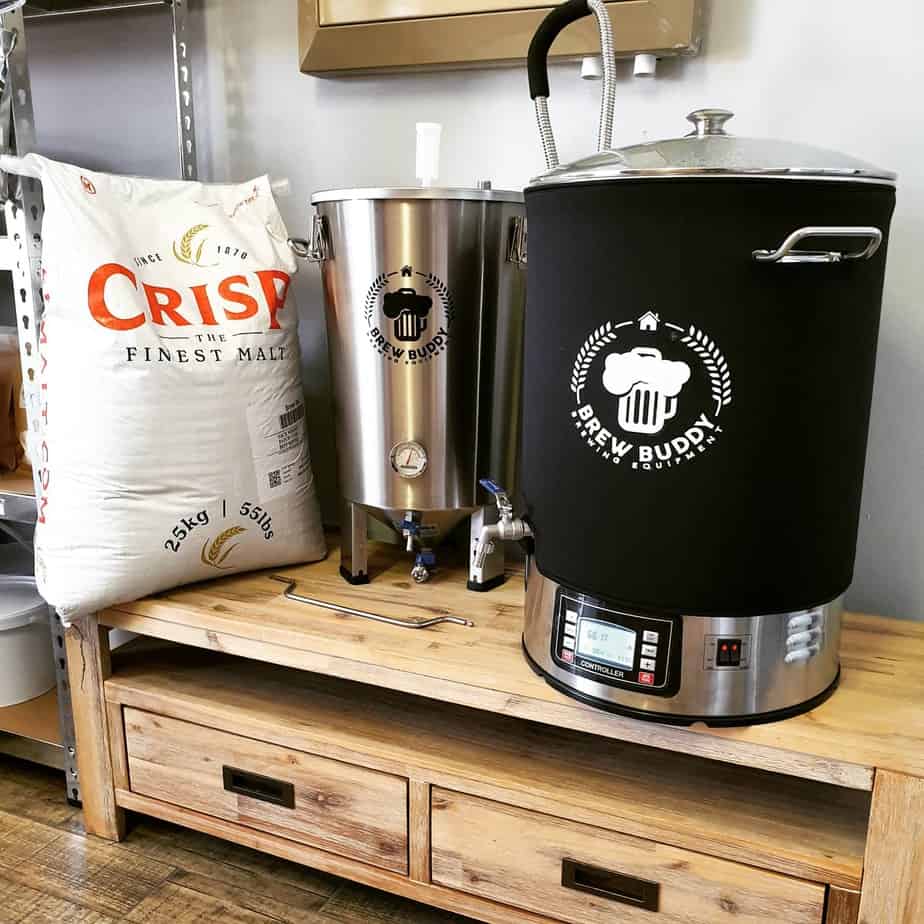How to brew your first beer
Let’s start with the important thing… do you have the recipe in front of you? If you do there is probably some things you might not know and we’re here to help!
The other important question is, are you BIAB (Brewing In A Bag) with an all-grain kit or are you doing an extract kit?
We share some terminology to help you understand how to brew and why you brew the way you do.
How to brew your first Extract Kit
- Clean all your equipment! Wash it clean and sanitize everything.
- Warm up about 5L of water
- Once the temp is reached, add in the extracts and the dextrose and mix well
- This is now called Wort
- Take a pre-boil gravity reading
- Boil your wort until you reach the ‘Hot-break’
- Once the ‘Hot-break’ happened your boiling time starts and hop additions can begin
- Add hops as indicated on the recipe. If it says 60 min you throw in the hop amount at 60mins of boiling time left. If it says 10 min you throw in the hop amount at 10 min left of your boiling time.
- Do hop-stand if needed.
- Add remaining water (this will also help cool down your beer)
- Cool beer down as quickly as possible to about 25°C. Pour wort vigorously so that you can aerate it as much as possible for the yeast.
- Add yeast to wort
- Close and ferment!
How to brew your first All-grain Kit
Terminology:
Mashing –
When you receive your grains you would first need to mash the grains in order to extract all the sugars from your grains that will eventually turn into alcohol. This means that if you do not do a proper mash then you would have insufficient sugars, nutrients, and goods to brew the specific beer you want. In the case of a low alcohol beer you would use a lot less grains because you do not want all that sugars and nutrients to feed your yeast and turn into alcohol.
Mashing Steps:
Strike Temp: This is the temperature your water needs to be when you throw your grains into the water.
Mash temp: This is the temperature that you need to keep your grains at for the duration of your mash, whether it be a 60 min mash or a 90 min mash or or or.
Mash out: After you spent your specified time mashing your grains, you would need to set the temp up to the mash out temp for the particular time specified on the recipe.
Sparging –
“Low and slow”… Well, some recipes have quite a high temperature for sparging but there is no need to sparge quickly just because the water is hot… So what’s the point? The point of sparging is to take your grains out of the water that you mashed it in and then rinse the remaining sugars and good off the grains. If your sparge water (think of it as your cleansing water) takes its time to flow through your grains then you will wash off more of the sugars that are still trapped on the grains.
Gravities. . .
Gravity readings are important for 1 reason at least… to know when your fermentation is done! The other reason is to make sure that you are getting the ABV that the recipe says you ought to get.
OG – Taking a gravity reading right before you add your yeast to your cooled down wort.
FG – Taking a gravity reading after fermentation (or to determine whether your fermentation is completed).
Pre-boil – Taking a reading after you have done your sparging and before you boil your wort.
So what happens here? Taking gravity readings help to determine whether you are getting enough sugars out of your grains to determine whether you have a efficient brew, otherwise you can take steps to adjust you r gravities if you are missing the mark.
A gravity reading refers to the total amount of dissolved solids in water, since we’re talking about beer, those dissolved solids are sugars. These sugars are consumed by yeast to convert the wort (unfermented ingredients) into beer.
Hot break… it’s a messy one
Once the proteins have coagulated this will cause your wort to make a creamy layer on top that will literally break as it boils. This process can be like boiling milk… waiting waiting and waiting where nothing happens and all of a sudden it boils over. DO NOT LET IT BOIL OVER! It’s messy, it’s sticky, and worse… it’s a waste of beer. The good news is that after this process nothing will boil over again and if you switch off the heat it will stop immediately, just like milk. Once this has happened, consider that your boiling time, as per recipe, has begun!
Hop Additions
Different hop additions are vital when you are creating your beer, especially if you have a complex beer. The time, alpha acids, weight, and origin is the key to creating your beer’s bitterness, aroma, and style!
When alpha acids are heated in a solution they go through a process called isomerization. Isomerized alpha acids are bitter to taste, and provide the characteristic hop bitterness in beer. Boiling hops for a longer period of time leads to more isomerization, and more bittering compounds in the finished beer.
Hopstand – This is an important process when you want to add hop flavour and aroma. The hot wort releases the essential oils but it does not boil the oils that causes for bitterness to be released.
Why dry hop? Because it is AROMATIC! Dry hopping gives you the opportunity to create a very aromatic and fresh tasting beer. Dry hopping is also easy, just make sure that you clean everything you use when dry hopping. Dry hopping in a hop bag makes it a lot easier to remove all the fine pieces the hops turns into as soon as it hits the liquid. Some people also put a (very clean) magnet in the hop bag and one on the lid, preventing you from opening your fermenter to add your dry hopping hops.
As soon as your beer stops boiling EVERYTHING needs to be CLEAN that enters your beer from that point on!!!!
IBU
International Bitterness Units.
What IBUs measure are the parts per million of isohumulone found in a beer. If you look at any hops details you will have a look at the following:
Alpha Acid: 2.5%-4.5%
Form: Pellet
Beta Acid: 4%-6%
Co-Humulone: 23%-28%
Total Oils: 0.4-0.8 mL/100g
These details on your hops packet will help you to determine which hops to use in your specific beers. That all comes with time, experience, knowledge… and making a few mistakes!
Fermentation
Patience is key when it comes to fermentation. Some yeasts ferment very slow (for example lager yeasts) and some yeasts can even finish fermenting within days (like the kveik strand). Not only is your yeast important for your fermentation but you have different yeasts that help create and that compliment the style of beer you are brewing. You also get neutral yeasts which are usually a great yeast to have spares of.
If you want to go deeper into the yeast styles go read about yeast strains and importance at When Homebrewing to Style, It’s All About the Yeast.
Priming Sugar
After you have fermented your beer then it comes to the fun side of your brewing phase, the tasting part. Yes, your beer will be room temperature (or at whichever temperature you fermented it) and it will be flat. Now you need the bubbles and when you bottle your beer you need Priming Sugar to convert to CO2 bubbles in your bottled beer. We believe the easiest way of adding your priming sugar is to dissolve it in boiling water (in a sanitized container), letting it cool down to room temp, then adding it into your bottling bucket. When you transfer your beer from your fermenting bucket to your bottling bucket you are sure to mix your priming sugar solution evenly and this will avoid have some bottles explode and some bottles being flat. It also spares you the effort of adding priming sugar to every single bottle!
Why the long wait??? Bottle conditioning and all that!
There’s nothing as dissatisfying as opening your first brewed beer and you see the foam gushing out of your bottle until you only have half a bottle left and a mouth full of beer… It is very satisfying, however, when you open a bottle, pour it, and it pours perfectly into your cold, clean beer glass… That is why you wait, to get that natural carbonation in your beer that forms from your priming sugar. Not only for your bragging rights and self esteem but it also gives your beer’s flavours time to settle and for you to have a beer that is smoother, better foam retention, and more complex flavours.
Now that we have gone through the terminology, here are the ‘How to brew’ steps for your all-grain kit.
How to brew… the steps. . .
- Clean all your equipment! Wash it clean and sanitize everything.
- Warm up your Mash Water to the Mash Temp/Strike Temp on the recipe (usually 65°C)
- Once the temp is reached, add in the grains and make sure everything is covered
- Mash your grains for said time on recipe (usually 60 min). Mash out if recipe calls for it.
- Whilst mashing, warm up your Sparge Water to the correct temp
- Pick up grains out of the mash water and Sparge the grains slowly to make sure you wash everything off and discard of grains however you please.
- This is now called Wort
- Take a pre-boil gravity reading
- Boil your wort until you reach the ‘Hot-break’
- Once the ‘Hot-break’ happened your boiling time starts and hop additions can begin
- Add hops as indicated on the recipe. If it says 60 min you throw in the hop amount at 60mins of boiling time left. If it says 10 min you throw in the hop amount at 10 min left of your boiling time.
- Do hop-stand if needed.
- Cool beer down as quickly as possible to about 25°C
- Pour wort vigorously so that you can aerate it as much as possible for the yeast.
- Add yeast to wort
- Close and ferment!
- Dry hop if necessary.
If our ‘How to brew’ post is still leaving you with questions, or leave you wanting to know more, do not hesitate to contact us for more information on how to brew tips and tricks!
Otherwise there is also this great book that you can read to learn everything you need to know, go check it out at How to brew


Thank you , a very interesting and helpful read
Very interesting details you have noted, regards for putting up.Raise your business